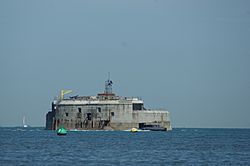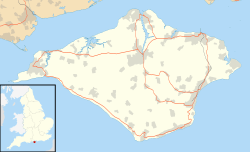St Helens Fort facts for kids
Quick facts for kids St Helens Fort |
|
|---|---|
| Solent, England | |

St Helens Fort
|
|
| Coordinates | 50°42′18.3″N 1°5′1.9″W / 50.705083°N 1.083861°W |
| Type | Fort |
| Site information | |
| Open to the public |
No |
| Official name | St Helen's Fort |
| Designated | 12 June 1967 |
| Reference no. | 1017370 |
|
Listed Building – Grade II
|
|
| Official name | St Helen's Fort |
| Designated | 18 May 1972 |
| Reference no. | 1034399 |
| Condition | Complete |
| Site history | |
| Built | 1867–1880 |
St Helens Fort is a strong fortress built in the sea. It is located in an area called the Solent, very close to the Isle of Wight in England. This fort is one of several known as the Palmerston Forts. These forts were built a long time ago to protect Britain from possible attacks. St Helens Fort was specifically designed to guard the St Helens anchorage, which is a safe place for ships to stop.
Contents
St Helens Fort: A Historic Sea Fortress
St Helens Fort was part of a big plan to protect the United Kingdom. This plan came from a special report in 1859. The fort was designed by Captain E. H. Stewart. Colonel W. F. D. Jervois helped to oversee the building work.
Building the Fort: Challenges and Changes
Construction of St Helens Fort began in 1865. It was finished in 1878, costing about £123,311. That was a huge amount of money back then! The building process was quite difficult. The fort had problems with the ground sinking, which is called subsidence. This meant the builders had to change their plans many times.
In the end, the fort was armed with powerful cannons. It had two large 10-inch (25 cm) guns facing the land. It also had one even bigger 12.5-inch (32 cm) gun facing the sea. These were called "rifled muzzle-loading" guns, meaning they had grooves inside the barrel to make the cannonball spin and fly further and more accurately.
Why Were These Forts Built?
St Helens Fort and the other Solent Forts are sometimes called "Palmerston's Follies." They got this nickname because they were built during a time when Britain was very worried about a French invasion. This fear was mainly because of Louis Napoleon III, the leader of France.
New ideas in French naval thinking also played a role. They focused on using smaller ships to attack ports. Also, the first ironclad (a ship covered in metal armor), the Gloire, was launched by France. This made older wooden warships seem less safe. Luckily, the threat of war with France lessened after France lost the Franco-Prussian War in 1870-71.
The Fort in Wartime
Even though the main threat from France passed, the forts were still useful. They were used for defence during both World War I and World War II. However, firing the very heavy cannons caused problems for people living nearby. The loud shock waves from the guns would often break windows in houses!
After the wars, the forts found a new purpose. They became important as lighthouses, helping ships navigate safely.
The Fort Today: Private Ownership and Public Walks
Today, St Helens Fort is owned by a private person. It is not open for the public to visit. It was put up for sale in 2003. If someone lived there, they wouldn't get normal local services. However, the fort has its own artesian well, which provides fresh water. During World War II, the fort was used to hold searchlights and anti-aircraft guns.
There is a special event that happens periodically, often in August. On one of the lowest tides of the year, many people walk from St Helens beach all the way out to the fort and back. On this day, a natural path appears from the sea. This path was originally used to carry building materials from the shore. People can also reach the fort by walking along a spit of land from Bembridge. After the walk, it's a tradition to have a barbecue on the beach. This event is not officially organized, but local yacht clubs provide safety boats.
Other sea forts in the area, which are all bigger than St Helens Fort, include Spitbank Fort, Horse Sand Fort, and No Man's Land Fort. As of 2020, these other forts were also privately owned. Spitbank and No Man's Land Forts have even been turned into hotels after being restored!


